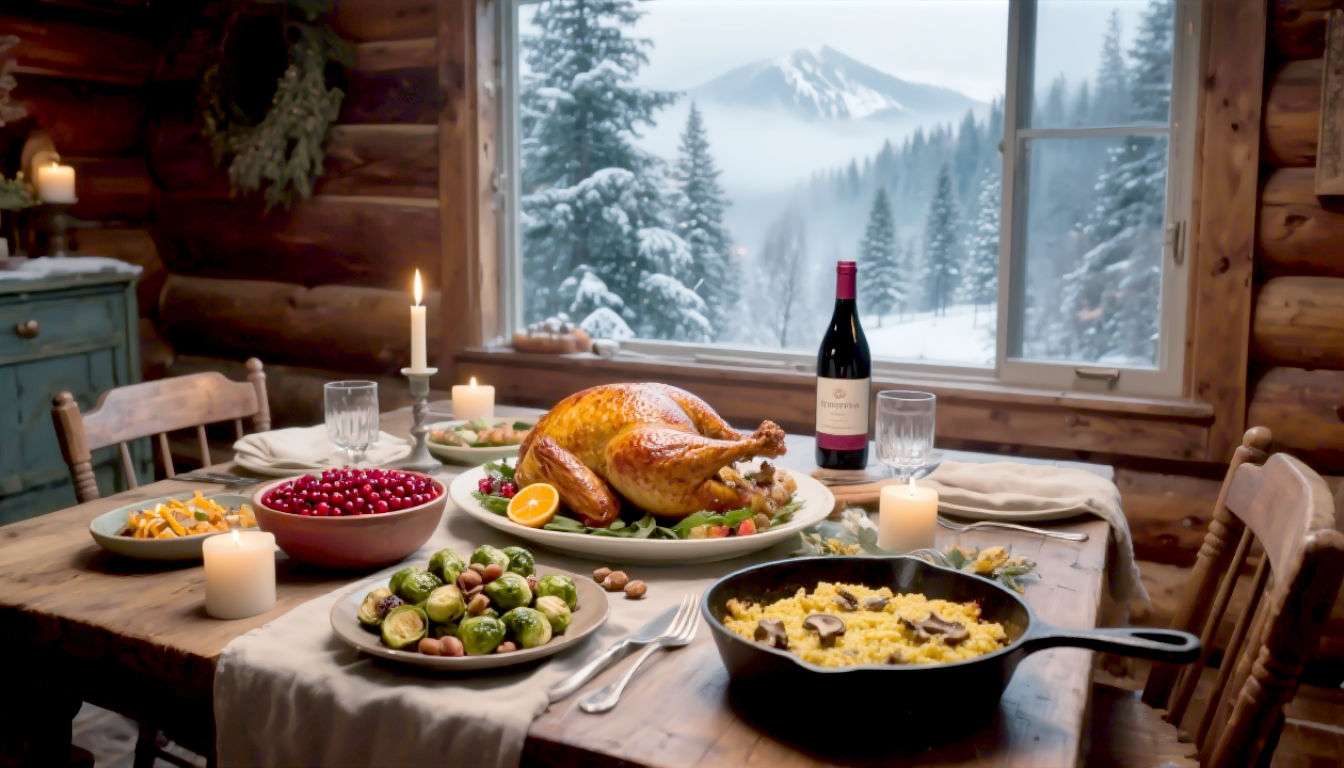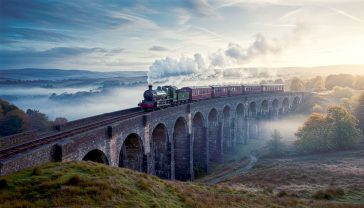The Story of Thanksgiving in Washington State: More Than Just Turkey
Forget the Pilgrims. Explore the unique history of Thanksgiving in Washington State, a story of salmon feasts, pioneer struggles, and blended traditions.

This post may contain affiliate links. If you make a purchase through these links, we may earn a commission at no additional cost to you.
Ah, Thanksgiving. For most of us Brits, it’s one of those quintessentially American things, like yellow school buses, baseball, and drive-thru everything. We picture families gathered around a massive turkey, watching American football, and maybe getting into a heated argument about politics. It all seems to stem from those Pilgrim Fathers in funny hats, sharing a meal with Native Americans back in the 1600s. But what if I told you that on the other side of America, in a corner of the country famous for rain, coffee, and tech giants, the story of Thanksgiving is a bit different?
Welcome to Washington State, a land of towering forests, volcanic mountains, and a rugged Pacific coastline. Here, the history of giving thanks is older, more complex, and far more interesting than just a single, famous meal. It’s a story that involves ancient tribal traditions, determined pioneers crossing a continent, and a president who wanted to unite a fractured nation. It’s a tale of survival, conflict, and the forging of a new identity in a wild and beautiful landscape.
So, grab a cuppa, and let’s journey across the pond to uncover the fascinating, and often surprising, history of Thanksgiving in Washington State. It’s a story that reveals a lot about America itself, and how a simple act of gratitude became a national institution.
Before the Pilgrims: The First Thanksgivings of the Pacific Northwest
Long before European ships ever dreamed of mapping the Pacific coast, the lands we now call Washington were home to dozens of vibrant Native American tribes. For peoples like the Coast Salish, the Chinook, the Yakama, and the Nez Perce, giving thanks wasn’t a once-a-year event; it was woven into the very fabric of their lives. Their world was one of cycles and seasons, and they marked each with ceremonies of gratitude.
These weren’t stuffy, formal affairs. They were lively celebrations tied to the gifts of the land and sea.
A Feast for the Salmon’s Return
For the tribes living along the mighty Columbia River and the coastal inlets, the most important event of the year was the return of the salmon. After months at sea, these incredible fish would surge back into the rivers to spawn, providing a vital source of food that would sustain communities through the long, damp winters.
The First Salmon Ceremony was a profound expression of thanks. When the first salmon of the season was caught, it was treated with the utmost respect. It would be carefully prepared and shared among the entire community in a special feast. The bones were then returned to the water, in the belief that this would ensure the salmon’s spirit would come back the following year, bringing its relatives with it. It was a beautiful ritual that honoured the connection between humans and nature, a core belief that life depended on a respectful, reciprocal relationship with the environment.
Celebrating the Bounty of the Land
Inland, other tribes held similar celebrations for the gifts of the earth. When spring arrived, and the first edible roots and berries appeared, communities would gather for a First Root Feast. Much like the salmon ceremony, the first harvest was a time for communal thanks. The women, who were the primary gatherers, would offer prayers and songs before digging the first roots, often camas bulbs or bitterroot. These would be cooked and shared, a celebration of the earth reawakening after winter.
These ancient traditions were Washington’s original Thanksgivings. They weren’t about pilgrims or turkey. They were about survival, community, and a deep, spiritual connection to the place they called home. They acknowledged that nature’s bounty was a gift, not a guarantee, and that gratitude was essential to maintaining balance in the world.
A New Kind of Thanksgiving Arrives
The 1800s brought seismic changes to the Pacific Northwest. Fur trappers, missionaries, and eventually, waves of American pioneers began to arrive, travelling thousands of miles along the arduous Oregon Trail. They brought with them their own customs, beliefs, and a very different idea of Thanksgiving.
This new version wasn’t tied to the salmon run or the camas harvest. It was a formal, government-declared holiday, rooted in the Puritan traditions of New England.
The First “American” Thanksgiving in the West
So, when did the first American-style Thanksgiving take place in Washington? The records are a little hazy, but one of the earliest documented events was in 1844 at a place called Tshimakain. Two Protestant missionaries, Cushing and Myra Eells and Elkanah and Mary Walker, had established a mission to the Spokane tribe. Far from their homes in the East, they observed a day of Thanksgiving, likely with a simple meal and prayers. It was a quiet, private affair, a way of holding onto their own culture in a strange and unfamiliar land.
As more settlers arrived, the tradition began to spread. These early pioneer Thanksgivings were a far cry from the lavish feasts we see today. They were often humble, practical affairs. The journey west was gruelling, and the first few years of carving out a homestead were a constant struggle. A Thanksgiving meal might consist of whatever was available: venison instead of turkey, wild berries instead of cranberry sauce, and rough-hewn vegetables from the first garden.
But the sentiment was powerful. For these pioneers, Thanksgiving was a moment to pause and reflect on their survival. They had made it across the plains, endured their first wet winter, and managed to plant a crop. They gave thanks for their sheer persistence and the hope of building a new life.
A Holiday Takes Root in a New Territory
In 1853, Washington officially became a territory, separate from Oregon. The first territorial governor, Isaac Stevens, was a man with a grand vision for the region. He also understood the power of shared traditions in building a sense of community among the scattered settlements.
That year, Governor Stevens issued Washington’s very first Thanksgiving Proclamation. He called on the citizens of the territory to set aside Thursday, the 29th of December, as a day for “public praise and thanksgiving to Almighty God.” This was a significant step. It transformed Thanksgiving from a personal or religious observance into a civic one, endorsed by the government.
However, not everyone celebrated. The holiday was still primarily an American, Protestant tradition. For the Native American tribes, this period was one of massive upheaval and loss as treaties were signed, lands were taken, and their way of life was irrevocably changed. For them, there was little to be thankful for in the arrival of the settlers. This starkly different experience is a crucial, and often overlooked, part of Washington’s Thanksgiving story.
From Lincoln to Statehood: Thanksgiving Becomes an Institution
For a long time, Thanksgiving in America was a bit of a free-for-all. Different states and territories celebrated on different days, if at all. That all changed during the darkest days of the American Civil War.
Lincoln’s Proclamation: A Call for Unity
In 1863, President Abraham Lincoln issued a proclamation that established Thanksgiving as a national holiday, to be celebrated on the last Thursday of November. His goal was to bring a divided country together, even symbolically, to reflect on its blessings amidst the horror of war.
This national declaration cemented Thanksgiving’s place in American life, including in the far-flung Washington Territory. From then on, the celebration became a regular, annual event. Newspapers in Seattle, Olympia, and Walla Walla would print the President’s and the Governor’s proclamations, and families would gather to mark the day.
The menu started to look a bit more familiar, too. As farms became more established and transportation improved, turkey began to replace venison as the centrepiece of the meal. Local produce like apples, pumpkins, and, yes, even oysters from the Puget Sound found their way onto the Thanksgiving table, creating a uniquely regional flavour.
Statehood and a New Identity
In 1889, Washington finally achieved statehood, becoming the 42nd state in the Union. This was a moment of immense pride. The early struggles of the pioneers were giving way to a new era of growth and prosperity, driven by industries like logging, fishing, and mining.
Thanksgiving in the new state of Washington took on a special significance. It was a celebration of how far they had come. The holiday became a symbol of civilised, settled life. Parades were organised, churches held special services, and sporting events, particularly local football matches, became part of the tradition.
It was also a time for charity. As cities like Seattle and Tacoma grew, so did their populations of the poor and needy. Civic groups and churches began organising free Thanksgiving dinners, a tradition that continues to this day. It reflected a growing sense of social responsibility and the idea that the community’s bounty should be shared.
The 20th Century: Tradition, Turmoil, and Turkey Trots
As Washington entered the 20th century, Thanksgiving became more and more like the holiday we recognise today. It was a blend of solemn tradition and commercial buzz.
The Great Depression and a Controversial Date Change
The 1930s were a tough time for everyone, and Washington was hit hard by the Great Depression. Thanksgiving during these years was a more subdued affair, a time to be grateful for the small things when so many had so little.
Then came a strange little episode that threw the whole country into a Thanksgiving tizzy. In 1939, President Franklin D. Roosevelt, hoping to boost the economy by extending the Christmas shopping season, declared that Thanksgiving would be celebrated a week earlier, on the third Thursday of November.
The nation was split! Some states went along with “Franksgiving,” while others stuck to the traditional date. For a couple of years, families in Washington had to figure out which Thanksgiving they were celebrating. It caused all sorts of confusion for school holidays and, crucially, for the big college football rivalries. The annual clash between the University of Washington Huskies and the Washington State University Cougars was a Thanksgiving institution, and rescheduling it was a nightmare.
Eventually, Congress stepped in and, in 1941, passed a law fixing the date for good: Thanksgiving would be the fourth Thursday in November. Everyone, including Washingtonians, could finally agree on when to eat their turkey.
Post-War Prosperity and Modern Traditions
The second half of the 20th century saw the rise of modern Thanksgiving traditions in Washington. The post-war economic boom meant that families had more to spend. The holiday became bigger, more elaborate, and more commercial.
- The Macy’s Parade: While New York has its famous Macy’s Thanksgiving Day Parade, Seattle has its own. For decades, the city’s downtown streets have been filled with floats, marching bands, and giant balloons on Thanksgiving morning, kicking off the official start of the Christmas shopping season.
- The Turkey Trot: For the more athletically inclined, the “Turkey Trot” has become a popular tradition. These fun runs are held in cities and towns across the state, giving people a chance to burn off some calories before the big feast.
- Black Friday: And, of course, there’s the day after Thanksgiving: Black Friday. Just like everywhere else in America, it marks a frantic rush to the shops for bargains, a loud and chaotic contrast to the day of quiet gratitude that precedes it.
Thanksgiving in Washington Today: A Holiday of Many Meanings
Today, Thanksgiving in Washington State is a rich and complex tapestry. It’s a holiday that means different things to different people, reflecting the diversity of the state itself.
A Time for Family and Food
For the vast majority of Washingtonians, Thanksgiving is, first and foremost, about family and food. It’s a time to travel, to gather with loved ones, and to share a meal that is both deeply traditional and uniquely personal.
The Washington Thanksgiving table is a testament to the state’s agricultural bounty. Yes, turkey is almost always the star, but the side dishes often have a distinctly local flavour.
- Apples: Washington is famous for its apples, and they feature heavily in pies, ciders, and stuffings.
- Seafood: In coastal communities, it’s not uncommon to find crab, oysters, or even salmon as part of the Thanksgiving spread.
- Mushrooms: The state’s forests provide a wonderful variety of wild mushrooms, which often appear in savoury side dishes.
- Wine and Craft Beer: Washington has a world-class wine industry and a thriving craft beer scene, and local beverages are a key part of the celebration.
Reclaiming the Narrative: Indigenous Perspectives
In recent years, there has been a growing and vital conversation about the darker side of the Thanksgiving story. For many Native Americans, the holiday is a painful reminder of colonisation, broken treaties, and the near-destruction of their cultures.
Many now observe the day not as a celebration, but as a National Day of Mourning. It is a time to reflect on their history, honour their ancestors, and educate others about the true story of what happened after the Pilgrims arrived.
In Washington, tribal communities are working to revitalise their own ancient traditions of gratitude. They are holding salmon ceremonies, celebrating their harvests, and teaching their children the importance of giving thanks in their own way. They are reminding everyone that the story of Thanksgiving in this land didn’t begin in 1621, but thousands of years earlier.
A Holiday for Everyone
Washington is also a state built by immigrants from all over the world. For these newer communities, Thanksgiving is a chance to participate in a classic American tradition while also infusing it with their own cultural heritage. A Thanksgiving dinner in a Vietnamese-American home in Seattle might include spring rolls alongside the turkey. An Indian-American family in Redmond might serve a spicy curry as one of the side dishes.
This blending of traditions is what makes the modern Washington Thanksgiving so vibrant. It has become a day for everyone, regardless of their background, to pause and give thanks for the blessings in their lives—for family, for friends, for community, and for the simple gift of sharing a meal together.
From the first salmon caught in a coastal river to the high-tech worker sharing a “Friendsgiving” potluck in a Seattle apartment, the spirit of gratitude has always been a part of life in Washington. It’s a story that is much bigger and more profound than a single historical event. It’s a continuous thread that connects the ancient past to the diverse present, reminding us that no matter who we are or where we come from, the simple act of giving thanks is something that unites us all.
Further Reading
For those interested in delving deeper into the history and cultural significance of Thanksgiving in the Pacific Northwest, here are some highly respected resources:
- HistoryLink.org: The premier online encyclopedia of Washington State history. A search for “Thanksgiving” or early territorial history will yield a wealth of detailed, well-researched articles.
- The Washington State Historical Society: Their website and museum in Tacoma offer extensive exhibits and resources on the state’s pioneer and Native American history.
- Burke Museum of Natural History and Culture: Located at the University of Washington, the Burke Museum has outstanding collections and online exhibits focused on the cultures of the Pacific Northwest’s First Peoples.
- The National Museum of the American Indian: A Smithsonian museum that provides crucial context on Native American perspectives on Thanksgiving and the National Day of Mourning.






